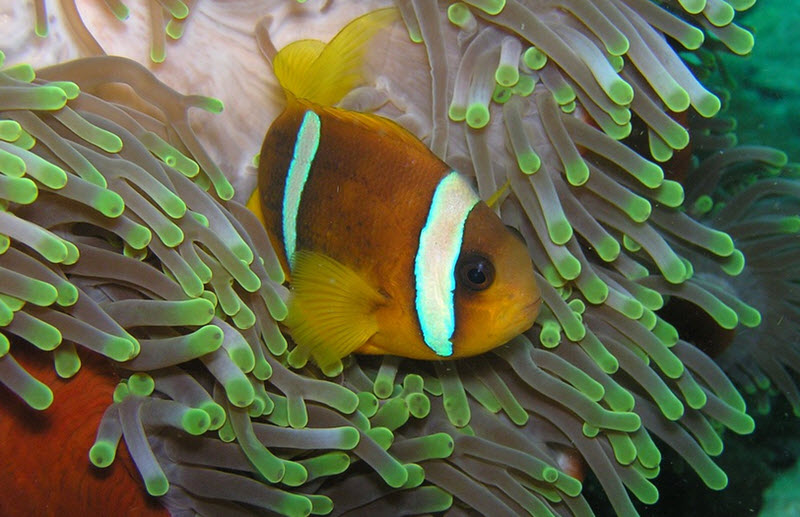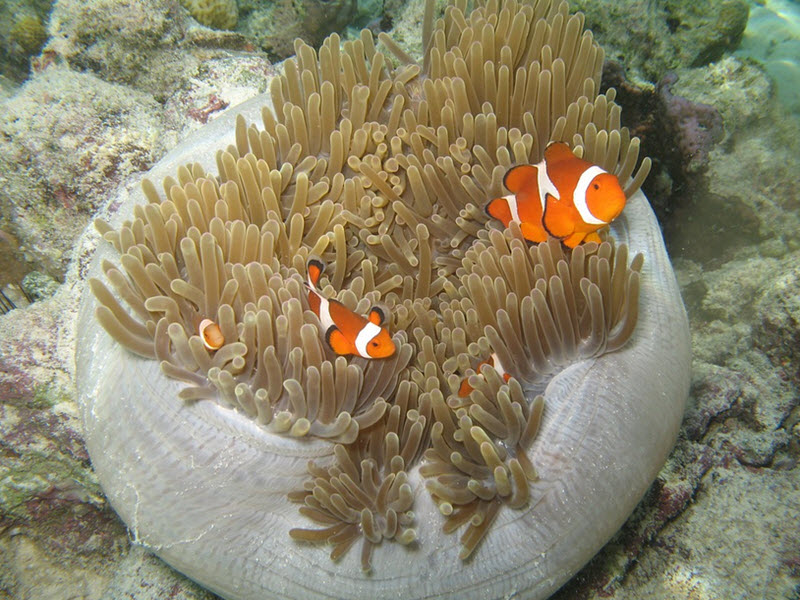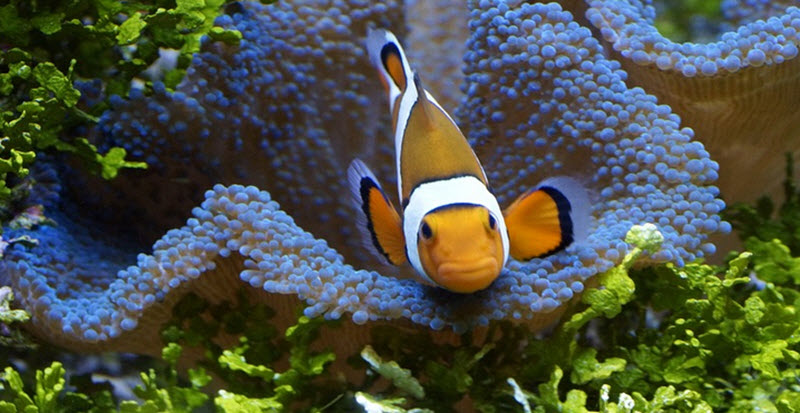Clownfish
Contents
- Clownfish isn’t their only name
- It is a diverse group of fish
- Where are they from?
- Why do they favor sea anemones?
- What do they look like?
- They have the incredible ability to change gender
- They are quite social
- The ideal water parameters and tank setup
- What do clownfish eat?
- What about tankmates?
- How to breed clownfish?
- Clownfish Articles
Thanks in part to the Finding Nemo and Finding Dory movies and due to their hardy nature, the clownfish has become the staple of the marine aquarium hobby. Yet, there is so much that is unknown about this rather gregarious and lively fish. Today we will explore everything there is to know about this awesome fish.
Clownfish isn’t their only name
They are also known as the anemone fish thanks to their symbiotic relationship with the sea anemone. In fact, most pictures of a clownfish will have a sea anemone in the vicinity. We will delve into that relationship in a minute.
It is a diverse group of fish
The classic clownfish is the one made popular by the movies and is orange in color with white bands and black tips to the fins. However, there is quite a lot of diversity in this family with over twenty individual species. They come in all kind of colors and sizes as well as prices. The good thing though is that they all share similar traits and it doesn’t matter which species you get. Let us find out more about the massively popular clownfish or the anemone fish.
Where are they from?
The clownfish is a native of the colder waters of the Indian and the Pacific Oceans. It can be found as far as the Red Sea and the Great Barrier Reef. It is, however, found only in certain areas in these places. It prefers shallow waters around reefs. It is a small fish and very vulnerable to the wide variety of predators in the oceans and that is why it is not found in the open waters. They also do not occur naturally in the Atlantic. They are also found towards the bottom of the water column and usually occur mostly near sea anemones.
Why do they favor sea anemones?
As we mentioned earlier and as you would be knowing already, the clownfish prefers being around the sea anemone. In fact, the two are almost always found in the wild together. You would be right to assume that they have a beneficial relationship which in science is known as a symbiotic relationship. However, it might not be beneficial in the way you think it is. The anemone actually has stingers with which it stings the clownfish as well. The clownfish though seems to be immune to these stings. Scientists aren’t sure as to exactly how it achieves this but two of the most popular theories suggest that the clownfish either has a natural immunity to the stings or that it has a thick layer of mucus on its body that protects it from these stings. What these stings do for sure is keep other fish, especially the kind that would eat the clownfish away. In return, the clownfish helps the anemone by cleaning it of parasites and bringing food to it. Any scraps that are left by the sea anemone is also cleaned up by the clownfish. Now the question is do you need a sea anemone to keep a clownfish in the home aquarium? The answer is a bit complicated. If you really want to make the clownfish at home and see it exhibiting some really cool natural behaviors like fetching food to the anemone then keep them together. However, it is not compulsory. If you are a beginner then do not keep the sea anemone as they are quite delicate and difficult to care for. The clownfish, on the other hand, are pretty easy to care for and rather hardy. Most clownfish sold in the aquarium trade are captive bred and do just fine without the sea anemone as long as you feed them and keep the water parameters just right. In fact, some captive-bred clownfish won’t even bond with a sea anemone.
What do they look like?
The clownfish makes up more than 40% of all marine fish sold in the aquarium hobby. That means that if you have been in a pet shop that sells marine fish then chances are pretty high that you have already seen a clownfish. The most common variety of clownfish is orange in color with three white bands. The middle band is wider and usually protrudes towards the face at the center. This is a stocky fish with rather large fins for its body. Other colors like black and grey are also found among different anemonefish or clownfish species. It stays relatively small at between 3 inches and 4 inches. Its somewhat stocky appearance makes it movements appear rather clownish possibly contributing to its name. The rounded off tails and dorsal fins and the spines on its dorsal fin enhance this appearance even further. The color variations are usually location specific but some rather exotic varieties have been bred giving rise to some really cool-looking and rather expensive clownfish varieties as well.
They have the incredible ability to change gender
You read that right. This is a fact not explored in the movies but one of those things that makes this fish really amazing. Due to its shy and somewhat secluded nature, it cannot go to the great lengths other fish go through to find a mate and procreate. Instead, all clownfish are born as males with the largest fish in the group turning female just before mating. This makes them prolific breeders and you can have your own clutch of young clownfish with almost no extra effort. This is a unique adaptation rarely seen among fish. Another cool advantage of this ability is that clownfish have a very structured way of going about their lives. The largest fish is the dominant female and the second largest is the dominant male. The rest have underdeveloped reproductive organs. If the dominant female dies or is replaced then the dominant male changes its gender and becomes the dominant female while one of the subdominant fishes takes his place. There is a catch though. Once a male transforms into a female, the change is permanent. This does bring an interesting scenario to mind. Can you keep two female clownfish together? The answer is a no. It is very important to keep in mind when buying mature fish to make sure that either there is only one female in the group or the aquarium is very large and has enough room to house two groups of clownfish led by different dominant females. Even then it can lead to trouble as dominant females are known to fight each other to the death.
Their weird sex lives aside, they are quite gregarious and social fish. They should always be kept in groups of at least four or more contrary to what the movies show. Getting sexually immature clownfish is the best way to begin with this fish as they can naturally form their social hierarchy without any conflicts or issues. They are incredibly intelligent too and have a clear language of popping and clicking noises that they use to communicate with each other. It is using these sounds that the dominant clownfish keeps the others in line and keep the group conflict-free. The breeding pair can exhibit some really interesting behavior traits such as feeding each other or grooming each other apart from the entire group taking care of their anemone if you have one. Aquarium shops often sell small tanks containing just two fish and while they do just fine if you want to see them exhibiting all of their wonderful traits then you have to have them in a tank larger than 10 gallons with at least four individuals. They also like taller tanks to wider or longer tanks.
The ideal water parameters and tank setup
The clownfish is a rather easy to care for fish. Tank sizes aren’t too demanding and pairs can be kept in tanks as small as 10 gallons while groups of four to six can be kept in tanks of less than 30 gallons. The reason we do not recommend a smaller tank is because the water parameters in these tanks can change quite drastically. They are more susceptible to changes in water temperature as well. This makes it absolutely necessary to always keep a close eye on all the parameters which can get tiring and this fish can be rather high maintenance in such cases, more than it needs to be. About 15 gallons for each pair is a great way to find the ideal tank size.
As far as the tank setup goes, you do not need any special type of decoration. Only get an anemone if you are up to the task of maintaining the very pristine conditions it needs to thrive. Otherwise keep the aquarium mostly bare, with a couple of false corals and a soft substrate of crushed corals.
The clownfish does best when the temperature is maintained between 73 °F and 80 °F or 22 °C and 27 °C. The pH should be maintained between 8.0 and 8.4. The specific gravity needs to be between 1.021 and 1.026. There should be no ammonia and the nitrites should be less than 0.2 ppm. Moderate lighting is required if you are just keeping the fish however, intense lighting is required if you are keeping the sea anemone as well. It is also important to have plenty of movement in the water and wavemakers are recommended though you can use a powerhead as well.
What do clownfish eat?
Their easy to care for nature extends to their feeding habits as well. They will accept a wide range of food and getting them to eat is never difficult. They can be fed pellets and flakes from reputed brands meant for carnivores and omnivores. However, like with any fish, a varied diet is the best way to keep them healthy. Try to include some frozen food and even live food if possible as the clownfish will stay more active and happy and will live longer. This will also allow them to exhibit more brilliant colorations. The frequency also varies. Young fish should be fed once every day with just enough food that they can finish off in two to three minutes. Mature fish can be fed once every other day.
What about tankmates?
This is a bit tricky. While they are small and rather docile most of the times, they can be quite aggressive too. First, let us talk about tankmates from the same species. As we mentioned earlier, unless you have an established pair, always introduce multiple clownfish that are still immature at the same time. Never introduce a mature fish into an aquarium that already has an established group. Even fully developed males should not be introduced in such an aquarium. Another big no-no is mixing different species. While they can get along well, chances are rather high for them to become hostile and lead to a fatal death match for the fish.
Coming to other fish, keep in mind that the clownfish is a slow swimmer and can be an easy target for large aggressive fish. Keep it with fish that have a peaceful temperament and won’t look at the clownfish as a prey item. Fishes that do well with clownfish are Damselfish, Tangs, Wrasses, Blennies, Angelfish, Dartfish, Puffers, Gobies, and Pseudochromis. Small invertebrates are also a great addition to a clownfish tank. They can be kept in bare tanks or with different varieties of soft and hard corals. An anemone as we mentioned can be hard to take care of and many captive bred fish tend to ignore the anemone altogether.
How to breed clownfish?
The first obvious step is choosing the fish. You can go about this two ways. You can put multiple juveniles together and let them form a breeding pair naturally. This is a time-consuming process as it can be a couple of years before one of them transforms into a female and becomes sexually mature. If you want a more instant result then get an established pair.
While they can be bred in a regular tank, it is recommended to set up a specialized breeding tank. It does not have to be high tech. A bare bottom tank with a clay pot for the fish to lay eggs is good enough. The fish can be triggered to breed by raising the temperature by a couple degrees and feeding them multiple times a day. The water conditions need to be maintained fastidiously.
Once the eggs are laid it is best to collect them and put them in a grow-out tank where they can hatch without the fear of being pulled into a powerhead. The eggs will usually hatch in 6-8 days and can be fed brine shrimp and other food meant for fish fry from the second day onwards. The temperature should be kept at a constant level in this tank or the fry can die quite easily. Getting the clownfish to breed is quite easy. It is getting the fry to grow up that can be difficult.
So, there you have it. The rather fascinating world of clownfish and the joys and intricacies associated with keeping this marine beauty as a pet. Keeping one of these can give lots of joy for the 5-7 years they tend to live.
Clownfish Articles
Black Clownfish – Information about Black clown fish
Breeding Clownfish – A very brief description on how to breed clownfish
Cinnamon Clownfish – Information about Cinnamon Clownfish
Clarkii Clownfish – Information about Clarkii Clownfish
Maroon Clownfish – Information about Maroon Clownfish
Ocellaris Clownfish – Information about Ocellaris Clownfish
Percula Clownfish – An article about how to keep and breed Percula breeding.
Pink Skunk Clownfish – Information about Pink Skunk Clownfish
Saddleback Clownfish – Information about Saddleback Clownfish
Tomato Clownfish – An in depth article about tomato clownfish.



